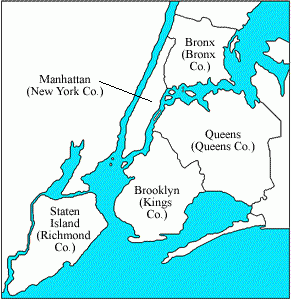The present City of New York, consisting of five boroughs, came into existence on January 1, 1898.
This article focuses on what the five-borough city replaced. This is important because the consolidation of 1898 (and others which preceded it) wiped off the map many jurisdictions which genealogists are going to encounter in their research.
Modern maps may not show these old cities, towns, or villages, so it is often difficult for genealogists to understand the place names they encounter in census, land, vital and other records before 1898.
After the English seized the City of New Amsterdam in 1664 and renamed it New York, they extended its boundaries to include all of Manhattan Island. In 1683, when the Province of New York was first divided into counties, the City of New York also became New York County.
The original city was a tiny area at the island's southern tip, the rest of Manhattan consisting of scattered farms and rural villages. Slowly the urbanized area spread northward. In 1874, to accommodate this growth, New York City and County annexed from Westchester County what is now the western Bronx. Meanwhile, the village of Brooklyn became a city and eventually expanded to cover all of Kings County.
In 1894 a vote was taken in New York, Westchester, Kings, Queens and Richmond counties on a proposal to combine New York City with Brooklyn, the eastern Bronx, part of Queens County, and all of Richmond County, to form the second largest city in the world (after London). There was a large majority for the proposal, but only because of the vote in New York County. Only 50.1% of Kings County voters were in favor, and some towns, such as Flushing in Queens County, were solidly opposed.
Nevertheless, the overall majority ruled, and consolidation went ahead. In 1895 New York City annexed the eastern Bronx. On January 1, 1898, the City of Brooklyn, Long Island City, and the towns and villages of western Queens and all of Richmond were replaced by the Boroughs of Brooklyn (Kings County), Queens (Queens County), and Richmond (Richmond County). With the Boroughs of Manhattan and The Bronx (New York County) they formed a new City of New York, briefly called "Greater New York."
Since 1898 there have been two important changes.
- In 1914, The Bronx became a separate county of the same name.
- In 1975, the Borough of Richmond was renamed the Borough of Staten Island, though remaining Richmond County.
Sources dated after January 1, 1898 may carry either the borough or county name, or both. In general, records generated by a city agency (such as the Department of Health) use the borough name, while those created by agencies of the state (such as the Surrogate's Court) use the county name, but this usage may not be consistent. Genealogists should be familiar with both sets of names.
Prior to 1898, the City of Brooklyn maintained records very similar to those of its sister city of New York, including vital records as early as 1848. When Long Island City was created in 1870 it also began to keep vital records. The towns of Kings, Queens, Richmond and Westchester (later Bronx) counties kept records similar to those maintained by towns in the rest of the state, including vital records in 1847-49 and beginning again in 1881. Within the towns, incorporated villages sometimes kept their own vital records after 1881 (the town/village of Morrisania kept some vital records at least as early as 1872).
The Municipal Archives of the City of New York, 31 Chambers Street, Manhattan, holds many surviving records of the old cities, towns and villages. See the description of the Archives' holdings at the Archives website, and in Genealogical Resources in New York, ed. Estelle M. Guzik (New York: Jewish Genealogical Society, 2003), pp. 113-124, especially the lists of vital records and descriptions of the Richmond County Clerk's and Town Records. See also Kings County Records from the St. Francis College Collection, Now at the Municipal Archives.
To understand the maps that follow, keep in mind that in New York State, counties are made up of towns and cities. Towns in turn consist of villages, which may be incorporated (and thus have some records of their own), or unincorporated (in which case their affairs are covered by the town records).
The Bronx
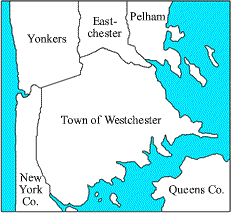
Map 2. Southern part of Westchester County prior to 1846, showing the town boundaries. The manor of Morrisania was made a town in 1788 but annexed to Westchester in 1791.
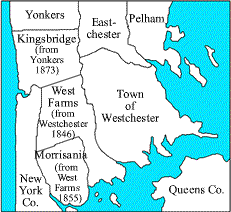
Map 3. Three towns, West Farms, Morrisania and Kingsbridge, were created between 1846 and 1873. In 1864 the entire town of Morrisania was also incorporated as a village.

Map 4. In 1874 New York City and County annexed from Westchester County the area south of the City of Yonkers and west of the Bronx River. The former towns of Morrisania, West Farms, and Kingsbridge became Wards 23 and 24 of the City, and were known as the "Annexed District." (Note: Although New York City continued to be divided into wards until the 1930s, the wards lost their political function as a result of reforms in the 1890s.)
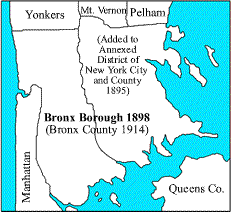
Map 5. In 1895 the Annexed District and Ward 24 were extended eastward to include all of the town of Westchester and parts of Pelham and Eastchester. These towns included some incorporated villages, of which only one, South Mount Vernon, had its own vital records which survive. At the consolidation of 1898, the Annexed District became the Borough of the Bronx, but remained part of New York County until Bronx County was created in 1914.
Kings County (Brooklyn)
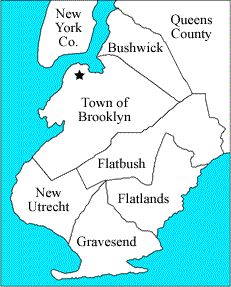
Map 6. Kings County towns before 1834. The star indicates the Village of Brooklyn, incorporated in 1816.

Map 7. In 1834 the Village and Town of Brooklyn were combined to form the City of Brooklyn. In 1827 the village of Williamsburgh was incorporated within the town of Bushwick; in 1840 it became a separate town, and in 1851 a city. In 1852 the eastern part of Flatbush became the Town of New Lots. In 1854 Williamsburgh and Bushwick were annexed to Brooklyn as the Eastern District of that city, usually abbreviated "E.D." (the original city was then briefly called the Western District).
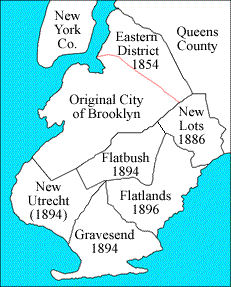
Map 8. Brooklyn annexed all the remaining towns 1886-96.
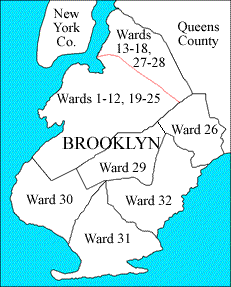
Map 9. Wards of the City 1896, and Borough 1898-.
Queens
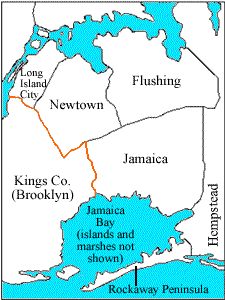
Map 10. Before 1870, Queens County consisted of the towns of Newtown, Flushing, Jamaica, North Hempstead, Hempstead, and Oyster Bay (not shown). The Rockaway Peninsula was part of the town of Hempstead.
In 1870 the western part of Newtown closest to New York City, including the village of Astoria, was incorporated as a separate city, called Long Island City.
On January 1, 1898, Long Island City, Newtown, Flushing, Jamaica, and the Rockaway Peninsula of Hempstead became the Borough of Queens, and were replaced by five wards:
- Long Island City became Ward 1
- Newtown Ward 2
- Flushing Ward 3
- Jamaica Ward 4
- Rockaway Ward 5.
There had been several incorporated villages in the former towns. Several of these briefly kept their own vital records which survive, namely:
- In the town of Flushing, the villages of:
- Flushing
- College Point
- Whitestone
- In the town of Jamaica, the villages of:
- Jamaica
- Richmond Hill
- In the Rockaway Peninsula of Hempstead, the villages of:
- Far Rockaway
- Rockaway Beach
The creation of the borough left the larger eastern portion of Queens County (Hempstead, North Hempstead and Oyster Bay) outside of the city. This political complication was resolved on January 1, 1899 when the three eastern towns became the new county of Nassau. After that date Queens County consisted only of the Borough of Queens, but it retained all of the pre-1899 county records.
Richmond County (Staten Island)

Map 11. Richmond County was originally divided into four towns, Castleton, Northfield, Southfield, and Westfield. In 1860 a fifth town, Middletown, was created from parts of Castleton and Southfield.
Castleton was the closest town to New York City (by ferry), and the first to lose its rural character. Its north shore was incorporated in 1866 as the village of New Brighton, and in 1872 the village boundaries were extended to include the entire town, so that Castleton and New Brighton covered the same area.
There were smaller incorporated villages in the other towns, of which the following have surviving vital records in addition to those of the towns:
- Port Richmond in Northfield
- Edgewater in both Middletown and Southfield
- Tottenville in Westfield.
On January 1, 1898 the Borough of Richmond was created, and the former towns became wards: Castleton/ New Brighton was Ward 1, Middletown Ward 2, Northfield Ward 3, Southfield Ward 4, and Westfield Ward 5. In 1975 the Borough of Richmond was renamed the Borough of Staten Island. The county continues to be known as Richmond.
by Harry Macy Jr., FASG, FGBS
Originally published in The NYG&B Newsletter, Winter 1998
Updated June 2011
© 2011 The New York Genealogical and Biographical Society
All rights reserved.
